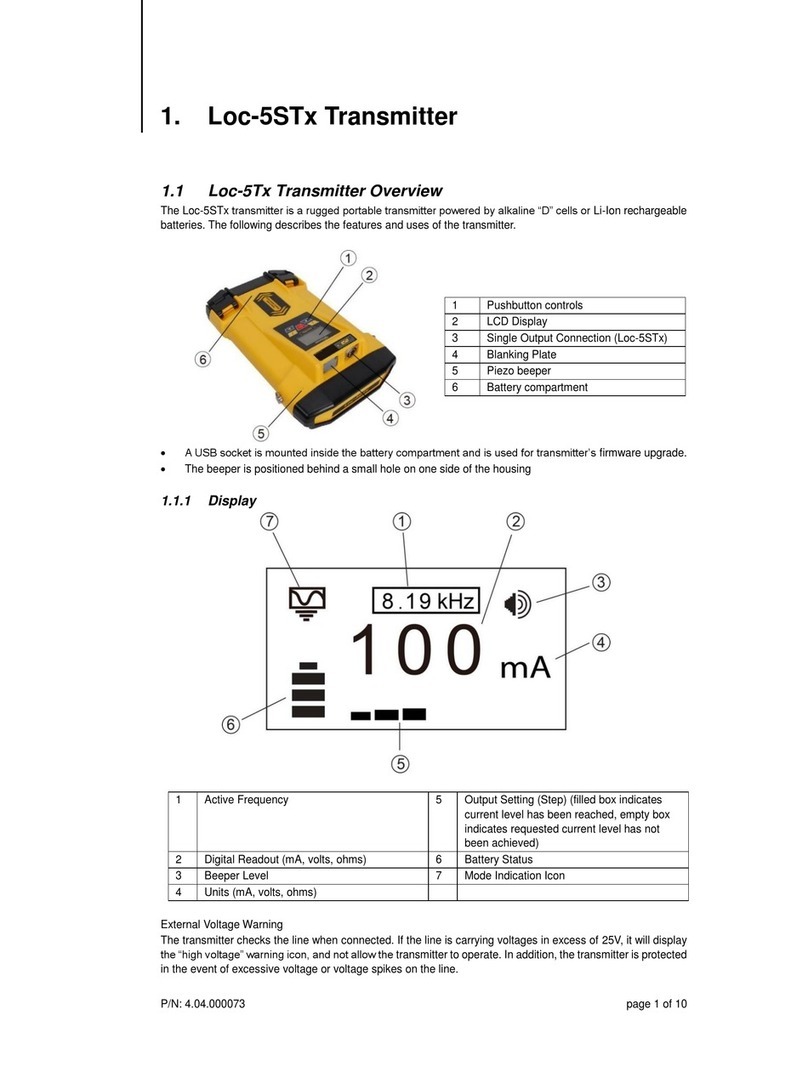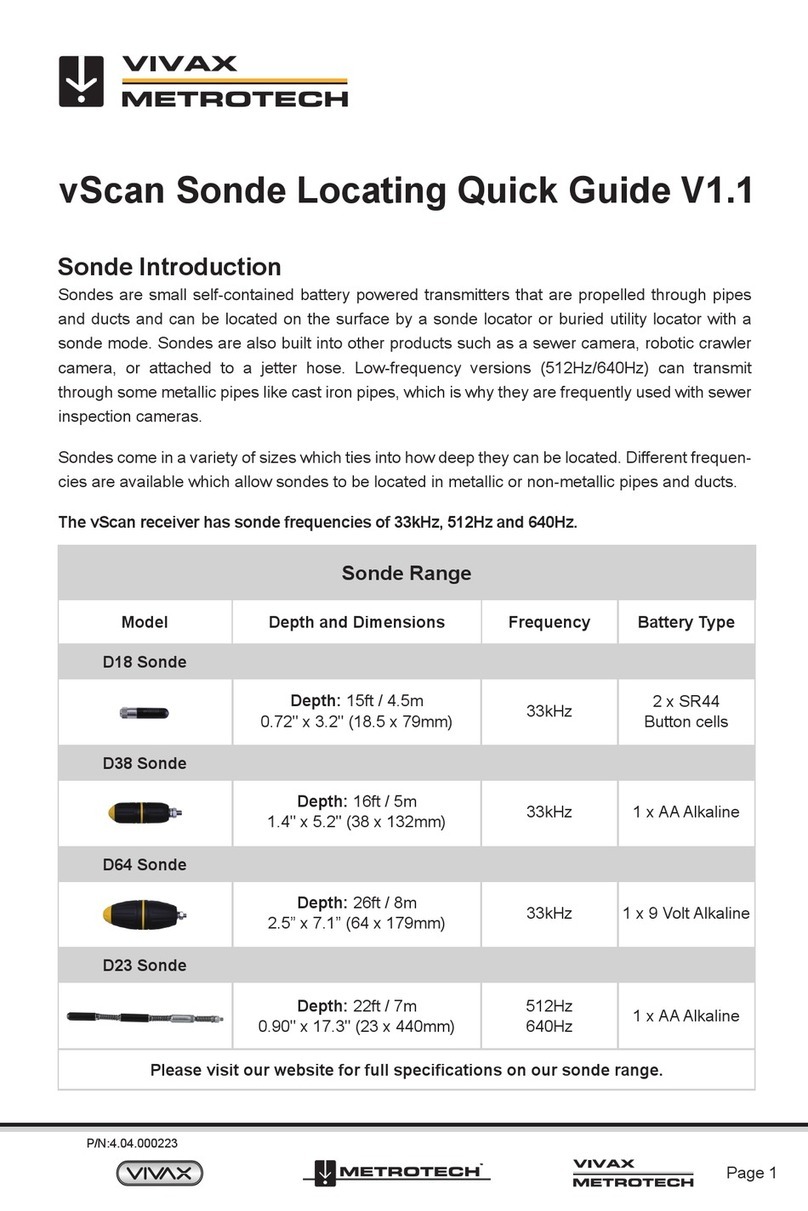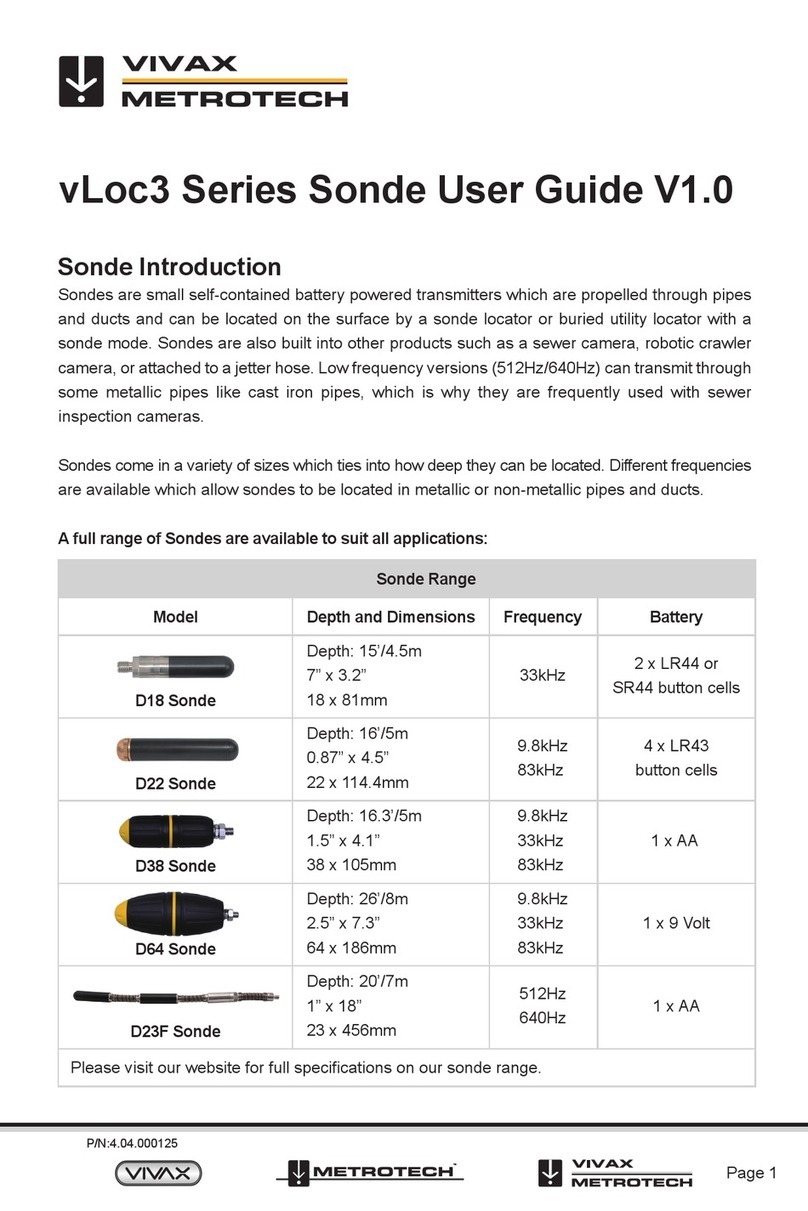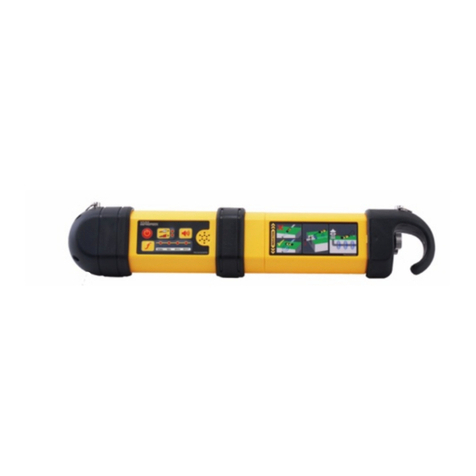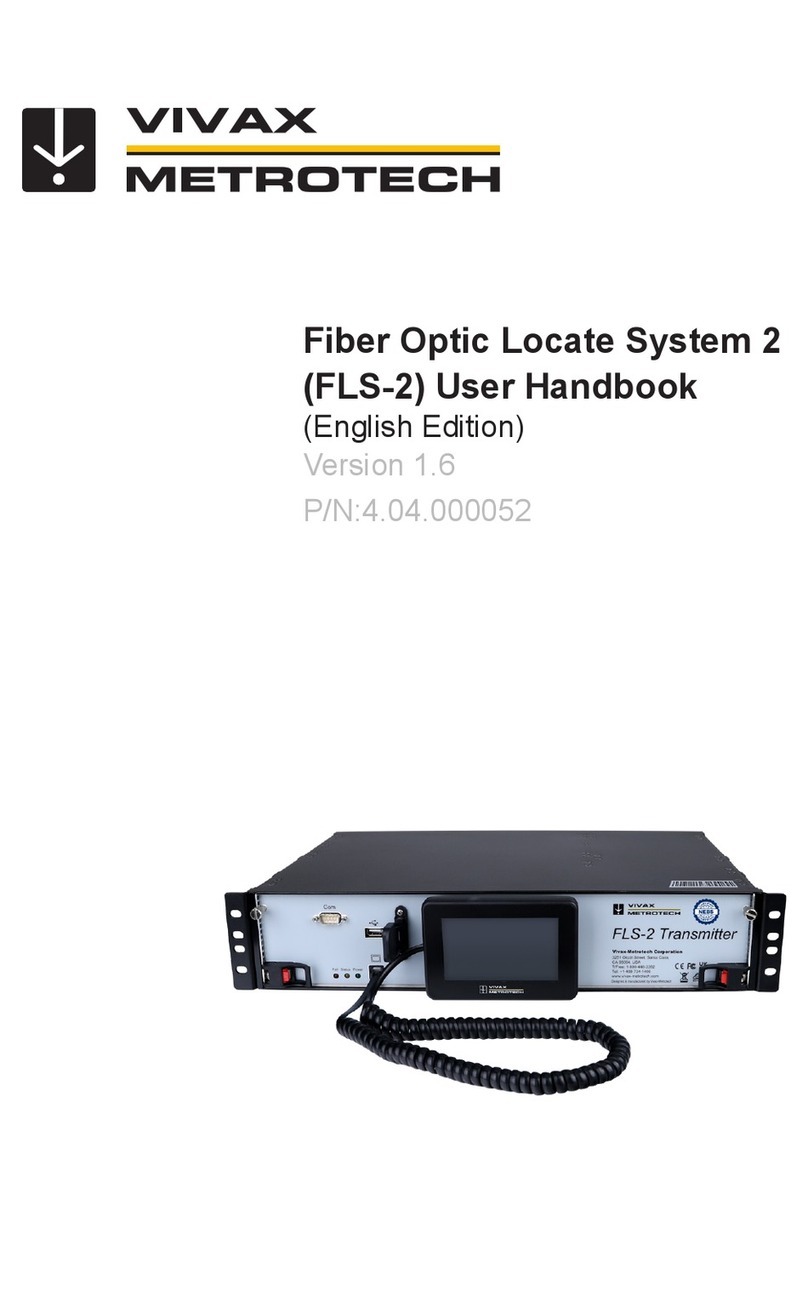Vivax Metrotech Loc3-25Tx User manual

www.vivax-metrotech.com
The Loc3-25Tx Transmitter Insert
™
This section of the manual covers the 25-Watt Loc3-25Tx transmitter.
1. Loc3-25Tx Transmitter Overview
The Loc3 series transmitters are rugged portable transmitters powered by Li-ion rechargeable batteries or alkaline “D” cells.
1
3
5
6
2
7
4
1Loc3-25Tx Transmitter
2 Li-ion battery tray
3 Carry bag
4AC/DC Adapter, Loc3-25Tx
5 Direct connection lead, Loc3-25Tx
6 Ground stake
7 Mini-USB lead
1.1 Display
4Hz/98Hz
39 0 mA
1 2
4
5
67
8
3
1 High Voltage Warning*
2 Active frequency
3 Mode icon
4 Units (mA, volts, ohms)
5 Speaker level
6 Output step bar graph
7 Battery level or DC Input icon
8 Digital readout (mA, volts, ohms)
*Output Protect Warning
The transmitter checks the line when connected. Output protected against accidental momentary connection to up to 230V
AC (RMS), it will display the “high voltage” warning icon and not allow the transmitter to operate. In addition, the transmitter is
protected by a 4A/250V fuse in the event of excessive voltage or voltage spikes on the line.
1.2 Pushbuttons
1 3
4 5
2
1On/O control
2 Frequency select
3Information (Volume, Volts, Ohms, Multi-frequencies
LCD contrast, Bluetooth menu, Frequency menu)
4 Output decrease/Navigate through the menu
5 Output increase/Navigate through the menu
Page 1
P/N: 4.04.000220

™
1.2.1 Information Pushbutton
Volume
Voltage
Resistance
LCD Contrast
Receiver Link
Frequency Menu
About
Pushbutton Pushbutton
When the “i” (information) pushbutton is pressed, the display will show the volume level of the audio; use the “+” and “-”
pushbuttons to increase/reduce the volume or turn the beeper o (o-low-medium-high).
Keep pressing the “i” (information) pushbutton, and the display can be toggled to show “voltage,” “resistance,” or other functions,
as shown in the drawing above. The display indicates mA as the default and volts or ohms when selected.
NOTE:
The number of “i” button presses and available sub-menus will vary with the transmitter's mode.
1.2.2 Connections Block
25-Watt Connection Block
12
4
FUSE
3
1 Output connection, speakON®socket
2 Output protection (4A/250V Fuse)
3 Loudspeaker
4 Battery charging socket & DC input
All locating connections are made via the connection block. Firmware updates are made via a USB socket mounted inside the
battery compartment.
The connection block consists of:
●Output (speakON®) socket (25-Watt transmitter) – for the direct connection lead.
●Charger socket (to charge rechargeable battery pack.
●Transmitter 19V DC power lead is used to power the transmitter from AC/DC power supply.
●Fuse, 4A/250V – this protects the transmitter circuitry in the event of the transmitter receiving up to 250V incoming voltage
on the output leads, or higher than the allowed current.
●A beeper is positioned behind the small hole.
2. Transmitter Batteries – Li-ion and Alkaline
The 25-watt transmitter ships with a custom Li-ion battery tray with a charger and power cable.
The battery status is shown on the transmitter's LCD. The letters “LP” will appear when the battery status reaches only one bar.
At this battery level, the max output current and power are limited.
The LED on the charger will show a red light indicating that the charge cycle is in progress. When the batteries are fully charged,
the LED will change to green.
Follow instructions detailed in the General Safety & Care Information section of this document. Dispose of batteries following
your company’s practice and environmental standards, the prevailing laws, or recognized best practice. Always dispose of
batteries responsibly.
Page 2

www.vivax-metrotech.com
The Loc3-25Tx Transmitter Insert
™
NOTE
The 25-watt transmitter ships with the Li-ion battery tray as a standard part. Alkaline can be used with
the 25-watt transmitter, but the power output will be limited to 10-watts.
WARNING
Use only Vivax-Metrotech recommended charger.
Do not attempt to replace the rechargeable batteries or remove battery covers.
Return to Vivax-Metrotech or a Vivax-Metrotech approved service center for replacement.
2.1 Charging the Transmitter Battery Tray
The rechargeable battery tray can be charged while attached to the transmitter or on its own.
1. Connect the charger to the charging socket on the transmitter's side or directly into the battery tray's charging socket.
2. The LED on the charger will glow red while charging and turn green when fully charged.
FUSE
Internal Charger Socket
Plug the charger into the charging socket on the side of the transmitter or directly into the battery tray.
NOTE
The rechargeable tray cannot be charged from a 12V DC source.
WARNING
Only use a charger supplied by Vivax-Metrotech Corp. Using non-approved chargers may result in
damage to the equipment or overheating/explosion.
The battery condition (charge) is displayed on the left side of the display.
Follow instructions detailed in the General Safety & Care Information section of this manual. Only use the battery charger
supplied as using an unapproved charger may damage the battery pack and may cause overheating.
2.2 Removing and Installing the Battery Tray
Removing the battery tray Installing the battery tray
FUSE
FUSE
1. Pull out the bottom of the catch
2. Lift the transmitter from the battery tray
1. Lower the transmitter into the tray
2. Push up button underneath the catch while holding it up.
3. Push in the bottom of the catch until you hear a positive
“click."
Page 3

™
3. Transmitter Mode
WARNING
Always connect the transmitter to a target line following all the company procedures. This operation
should only be performed by authorized personnel. Always make connections before switching on the
unit. Switch o before disconnecting the transmitter.
NOTE
When the transmitter is powered on without connection leads, a “NO CONNECTION” message will
appear. Power o the transmitter and insert the connection leads, and procced with power up.
NO CONNECTION
3.1 Direct Connection Mode
The Direct Connection mode is automatically selected by plugging a connection lead into the output socket. An icon conrming
the direct connection mode is shown on the display. The wave in the icon uctuates when the transmitter is operating. The direct
connection lead consists of two colored cables with clips and covers. The red clip must be connected to the conductor being
located, the black clip to a suitable ground such as the ground stake provided with the transmitter.
A good connection is indicated by a change in the beep rate from the speaker and the current reading on the display.
FUSE
Wherever a direct connection can be safely made without the risk of injury, damage to the customer’s plant, or the transmitter, it
is the best way of applying the transmitter’s signal.
The positioning of the ground connection can also inuence the degree of coupling experienced. Ground connections generally
should not be made to other pipes or cables or above ground metallic structures such as wire fences. In general, the lower the
frequency is, the further the signal will travel, and the less signal-coupling will occur. The most common frequencies used for
direct connection are between 512 Hz/640 Hz and 8 kHz.
Regulations in many countries require that power output is limited above specic frequencies. The Loc3 series 5-watt,10-watt,
and 25-watt transmitters enable frequencies below 45 kHz to be transmitted using as much as 5-watts,10-watts or 25-watt
output, depending on your transmitter, but frequencies over 45 kHz are restricted to 1-watt. Using direct connection and the
higher power at the low frequencies helps signicantly in achieving greater location distances. Direct connections should not be
made to cables carrying greater than 25V (or as your safety practices allow). The transmitter is protected (250V fuse) from stray
currents that may exist on the target line.
Page 4

www.vivax-metrotech.com
The Loc3-25Tx Transmitter Insert
™
3.2 Clamp Mode
The transmitter signal clamp is a precise way to apply the locate signal. Clamps are generally used when it is impossible to
access the conductor to make a direct connection, but there is access to place the clamp around the cable. Clamps are also
used when it is not safe to connect because the target cable is live carrying electricity.
The clamp is a specialized inductive device (sometimes known as a toroid or coupler). All clamps are optimized to work at
specic frequencies. In most cases, clamps are designed to be used at frequencies generally between 8 kHz and 9.82 kHz. The
transmitter will only allow the selection of a suitable range of frequencies for your clamp.
Plugging a Vivax-Metrotech clamp into the output socket will place the transmitter into the “Clamp” mode. An icon conrming this
is shown on the display and will ash when the transmitter is transmitting.
When using the clamp, no ground connection is needed.
FUSE
WARNING
When applying the clamp to cables that carry electricity – be sure to follow your company’s safety
instructions and procedures. Beware that if applied around a high voltage cable – that cable may
induce a current in the clamp, causing it to snap shut or jump quite dramatically – always apply
clamps carefully.
4. Transmitter Frequencies
The Loc3-25Tx transmitters are supplied with a predefined set of transmitting frequencies. The factory will preset the most
commonly used frequencies. Additional frequencies are available to be selected in the frequencies list; see section 4.2.
4.1 Frequencies and Maximum Power Output
Frequencies power outputs Loc3-25Tx
Direct connection 25-watt: 32Hz-9.82kHz
Pushbutton Pushbutton
4Hz/128Hz
3Hz/128Hz
4Hz/8Hz/128Hz
4Hz/8Hz/512Hz
4Hz/8Hz/128Hz
8.19kHz
512Hz
128Hz
As with most manufacturers, signal clamps are tuned to specic frequencies and will not work over the complete range of
frequencies.
Frequencies are selected by pressing the “f” pushbutton, which toggles through the frequencies available in the current mode's
available frequencies. The frequency is automatically selected if you don’t toggle past it within two seconds.
Page 5
Table of contents
Other Vivax Metrotech Transmitter manuals
Popular Transmitter manuals by other brands

Geo
Geo Web Pack quick start guide

Inovonics
Inovonics EchoStream EN1210W installation instructions

IKONNIK
IKONNIK KA-6 quick start guide

Rohde & Schwarz
Rohde & Schwarz SR8000 Series System manual

Audio Technica
Audio Technica UniPak ATW-T93 Installation and operation

NIVELCO
NIVELCO EasyTREK SCA-300 Series Programming manual
